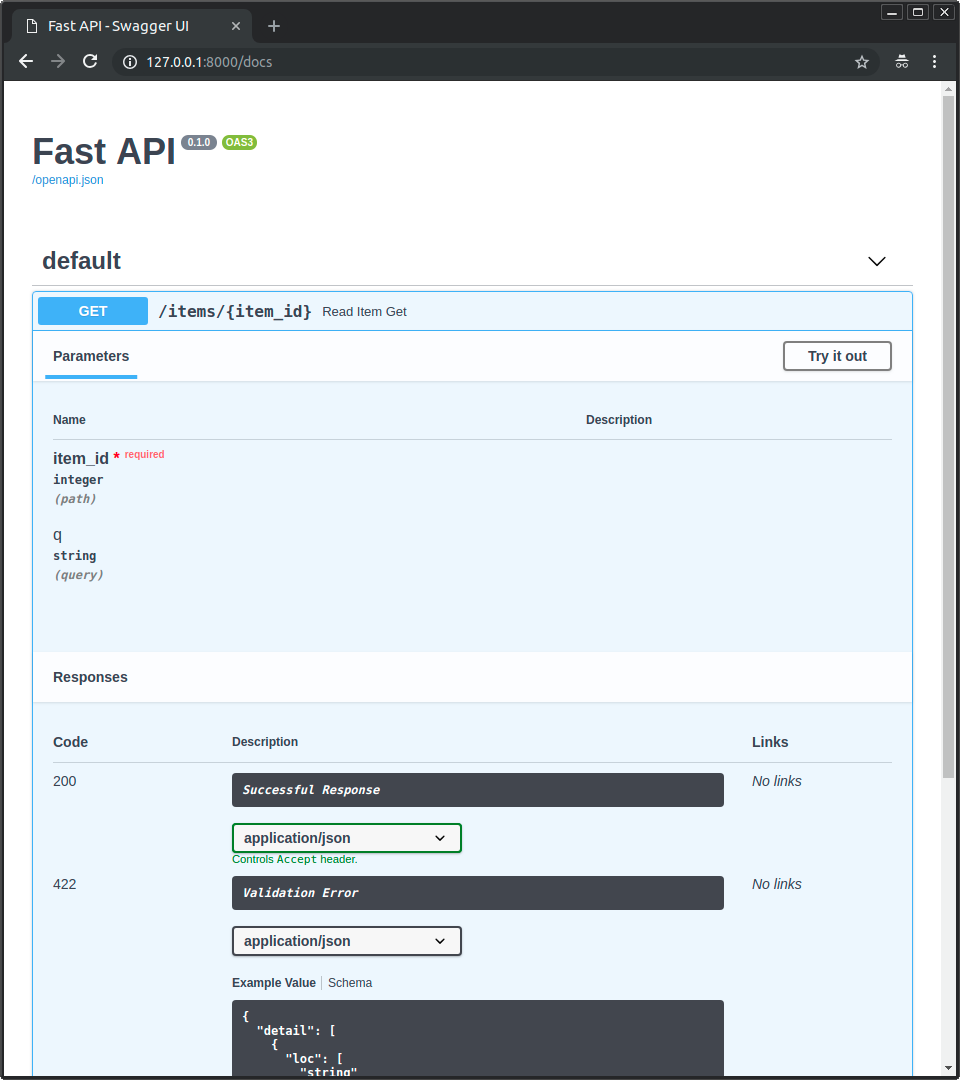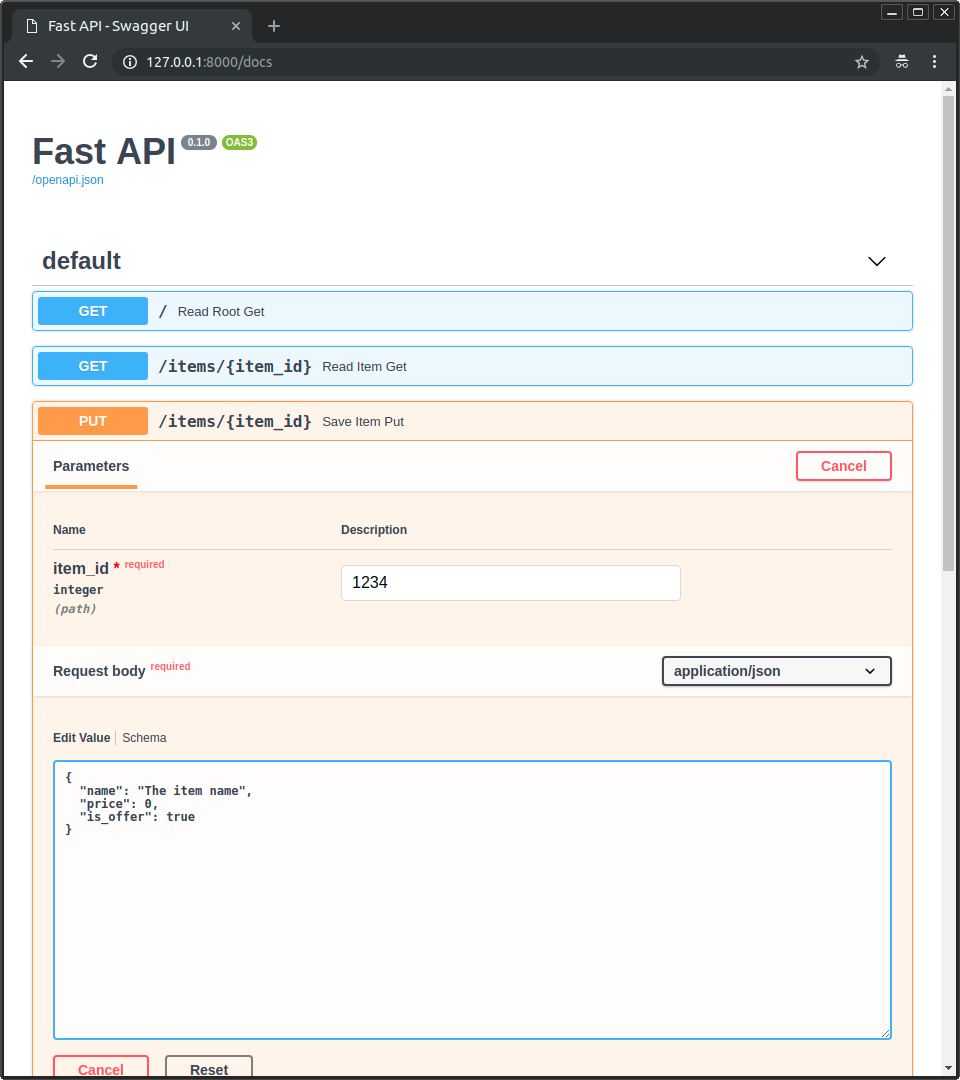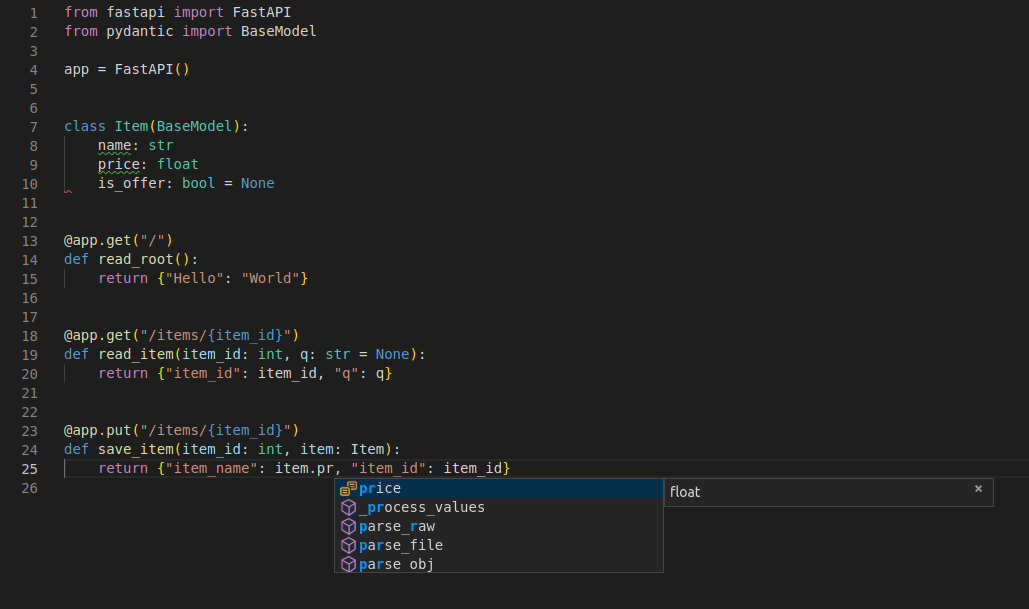Bug#977492: ITP: fastapi -- modern, fast, web framework for building APIs, based on type hints
Package: wnpp
Severity: wishlist
Owner: Sandro Tosi <morph@debian.org>
* Package name : fastapi
Version : 0.62.0
Upstream Author : Sebastián RamÃrez <tiangolo@gmail.com>
* URL : https://github.com/tiangolo/fastapi
* License :
Programming Lang: Python
Description : modern, fast, web framework for building APIs, based on type hints
Binary package names: python3-fastapi
<p align="center">
<a href="https://fastapi.tiangolo.com";><img src="https://fastapi.tiangolo.com/img/logo-margin/logo-teal.png"; alt="FastAPI"></a>
</p>
<p align="center">
<em>FastAPI framework, high performance, easy to learn, fast to code, ready for production</em>
</p>
<p align="center">
<a href="https://github.com/tiangolo/fastapi/actions?query=workflow%3ATest"; target="_blank">
<img src="https://github.com/tiangolo/fastapi/workflows/Test/badge.svg"; alt="Test">
</a>
<a href="https://codecov.io/gh/tiangolo/fastapi"; target="_blank">
<img src="https://img.shields.io/codecov/c/github/tiangolo/fastapi?color=%2334D058"; alt="Coverage">
</a>
<a href="https://pypi.org/project/fastapi"; target="_blank">
<img src="https://img.shields.io/pypi/v/fastapi?color=%2334D058&label=pypi%20package"; alt="Package version">
</a>
</p>
.
---
.
**Documentation**: <a href="https://fastapi.tiangolo.com"; target="_blank">https://fastapi.tiangolo.com</a>
.
**Source Code**: <a href="https://github.com/tiangolo/fastapi"; target="_blank">https://github.com/tiangolo/fastapi</a>
.
---
.
FastAPI is a modern, fast (high-performance), web framework for building APIs with Python 3.6+ based on standard Python type hints.
.
The key features are:
.
* **Fast**: Very high performance, on par with **NodeJS** and **Go** (thanks to Starlette and Pydantic). [One of the fastest Python frameworks available](#performance).
.
* **Fast to code**: Increase the speed to develop features by about 200% to 300%. *
* **Fewer bugs**: Reduce about 40% of human (developer) induced errors. *
* **Intuitive**: Great editor support. <abbr title="also known as auto-complete, autocompletion, IntelliSense">Completion</abbr> everywhere. Less time debugging.
* **Easy**: Designed to be easy to use and learn. Less time reading docs.
* **Short**: Minimize code duplication. Multiple features from each parameter declaration. Fewer bugs.
* **Robust**: Get production-ready code. With automatic interactive documentation.
* **Standards-based**: Based on (and fully compatible with) the open standards for APIs: <a href="https://github.com/OAI/OpenAPI-Specification"; class="external-link" target="_blank">OpenAPI</a> (previously known as Swagger) and <a href="https://json-schema.org/"; class="external-link" target="_blank">JSON Schema</a>.
.
<small>* estimation based on tests on an internal development team, building production applications.</small>
.
## Gold Sponsors
.
<!-- sponsors -->
.
<a href="https://www.deta.sh/?ref=fastapi"; target="_blank" title="The launchpad for all your (team's) ideas"><img src="https://fastapi.tiangolo.com/img/sponsors/deta.svg";></a>
.
<!-- /sponsors -->
.
<a href="https://fastapi.tiangolo.com/fastapi-people/#sponsors"; class="external-link" target="_blank">Other sponsors</a>
.
## Opinions
.
"_[...] I'm using **FastAPI** a ton these days. [...] I'm actually planning to use it for all of my team's **ML services at Microsoft**. Some of them are getting integrated into the core **Windows** product and some **Office** products._"
.
<div style="text-align: right; margin-right: 10%;">Kabir Khan - <strong>Microsoft</strong> <a href="https://github.com/tiangolo/fastapi/pull/26"; target="_blank"><small>(ref)</small></a></div>
.
---
.
"_We adopted the **FastAPI** library to spawn a **REST** server that can be queried to obtain **predictions**. [for Ludwig]_"
.
<div style="text-align: right; margin-right: 10%;">Piero Molino, Yaroslav Dudin, and Sai Sumanth Miryala - <strong>Uber</strong> <a href="https://eng.uber.com/ludwig-v0-2/"; target="_blank"><small>(ref)</small></a></div>
.
---
.
"_**Netflix** is pleased to announce the open-source release of our **crisis management** orchestration framework: **Dispatch**! [built with **FastAPI**]_"
.
<div style="text-align: right; margin-right: 10%;">Kevin Glisson, Marc Vilanova, Forest Monsen - <strong>Netflix</strong> <a href="https://netflixtechblog.com/introducing-dispatch-da4b8a2a8072"; target="_blank"><small>(ref)</small></a></div>
.
---
.
"_Iâ??m over the moon excited about **FastAPI**. Itâ??s so fun!_"
.
<div style="text-align: right; margin-right: 10%;">Brian Okken - <strong><a href="https://pythonbytes.fm/episodes/show/123/time-to-right-the-py-wrongs?time_in_sec=855"; target="_blank">Python Bytes</a> podcast host</strong> <a href="https://twitter.com/brianokken/status/1112220079972728832"; target="_blank"><small>(ref)</small></a></div>
.
---
.
"_Honestly, what you've built looks super solid and polished. In many ways, it's what I wanted **Hug** to be - it's really inspiring to see someone build that._"
.
<div style="text-align: right; margin-right: 10%;">Timothy Crosley - <strong><a href="https://www.hug.rest/"; target="_blank">Hug</a> creator</strong> <a href="https://news.ycombinator.com/item?id=19455465"; target="_blank"><small>(ref)</small></a></div>
.
---
.
"_If you're looking to learn one **modern framework** for building REST APIs, check out **FastAPI** [...] It's fast, easy to use and easy to learn [...]_"
.
"_We've switched over to **FastAPI** for our **APIs** [...] I think you'll like it [...]_"
.
<div style="text-align: right; margin-right: 10%;">Ines Montani - Matthew Honnibal - <strong><a href="https://explosion.ai"; target="_blank">Explosion AI</a> founders - <a href="https://spacy.io"; target="_blank">spaCy</a> creators</strong> <a href="https://twitter.com/_inesmontani/status/1144173225322143744"; target="_blank"><small>(ref)</small></a> - <a href="https://twitter.com/honnibal/status/1144031421859655680"; target="_blank"><small>(ref)</small></a></div>
.
---
.
## **Typer**, the FastAPI of CLIs
.
<a href="https://typer.tiangolo.com"; target="_blank"><img src="https://typer.tiangolo.com/img/logo-margin/logo-margin-vector.svg"; style="width: 20%;"></a>
.
If you are building a <abbr title="Command Line Interface">CLI</abbr> app to be used in the terminal instead of a web API, check out <a href="https://typer.tiangolo.com/"; class="external-link" target="_blank">**Typer**</a>.
.
**Typer** is FastAPI's little sibling. And it's intended to be the **FastAPI of CLIs**. â?¨ï¸? ð???
.
## Requirements
.
Python 3.6+
.
FastAPI stands on the shoulders of giants:
.
* <a href="https://www.starlette.io/"; class="external-link" target="_blank">Starlette</a> for the web parts.
* <a href="https://pydantic-docs.helpmanual.io/"; class="external-link" target="_blank">Pydantic</a> for the data parts.
.
## Installation
.
<div class="termy">
.
```console
$ pip install fastapi
.
---> 100%
```
.
</div>
.
You will also need an ASGI server, for production such as <a href="https://www.uvicorn.org"; class="external-link" target="_blank">Uvicorn</a> or <a href="https://gitlab.com/pgjones/hypercorn"; class="external-link" target="_blank">Hypercorn</a>.
.
<div class="termy">
.
```console
$ pip install uvicorn
.
---> 100%
```
.
</div>
.
## Example
.
### Create it
.
* Create a file `main.py` with:
.
```Python
from typing import Optional
.
from fastapi import FastAPI
.
app = FastAPI()
.
.
@app.get("/")
def read_root():
return {"Hello": "World"}
.
.
@app.get("/items/{item_id}")
def read_item(item_id: int, q: Optional[str] = None):
return {"item_id": item_id, "q": q}
```
.
<details markdown="1">
<summary>Or use <code>async def</code>...</summary>
.
If your code uses `async` / `await`, use `async def`:
.
```Python hl_lines="9 14"
from typing import Optional
.
from fastapi import FastAPI
.
app = FastAPI()
.
.
@app.get("/")
async def read_root():
return {"Hello": "World"}
.
.
@app.get("/items/{item_id}")
async def read_item(item_id: int, q: Optional[str] = None):
return {"item_id": item_id, "q": q}
```
.
**Note**:
.
If you don't know, check the _"In a hurry?"_ section about <a href="https://fastapi.tiangolo.com/async/#in-a-hurry"; target="_blank">`async` and `await` in the docs</a>.
.
</details>
.
### Run it
.
Run the server with:
.
<div class="termy">
.
```console
$ uvicorn main:app --reload
.
INFO: Uvicorn running on http://127.0.0.1:8000 (Press CTRL+C to quit)
INFO: Started reloader process [28720]
INFO: Started server process [28722]
INFO: Waiting for application startup.
INFO: Application startup complete.
```
.
</div>
.
<details markdown="1">
<summary>About the command <code>uvicorn main:app --reload</code>...</summary>
.
The command `uvicorn main:app` refers to:
.
* `main`: the file `main.py` (the Python "module").
* `app`: the object created inside of `main.py` with the line `app = FastAPI()`.
* `--reload`: make the server restart after code changes. Only do this for development.
.
</details>
.
### Check it
.
Open your browser at <a href="http://127.0.0.1:8000/items/5?q=somequery"; class="external-link" target="_blank">http://127.0.0.1:8000/items/5?q=somequery</a>.
.
You will see the JSON response as:
.
```JSON
{"item_id": 5, "q": "somequery"}
```
.
You already created an API that:
.
* Receives HTTP requests in the _paths_ `/` and `/items/{item_id}`.
* Both _paths_ take `GET` <em>operations</em> (also known as HTTP _methods_).
* The _path_ `/items/{item_id}` has a _path parameter_ `item_id` that should be an `int`.
* The _path_ `/items/{item_id}` has an optional `str` _query parameter_ `q`.
.
### Interactive API docs
.
Now go to <a href="http://127.0.0.1:8000/docs"; class="external-link" target="_blank">http://127.0.0.1:8000/docs</a>.
.
You will see the automatic interactive API documentation (provided by <a href="https://github.com/swagger-api/swagger-ui"; class="external-link" target="_blank">Swagger UI</a>):
.

.
### Alternative API docs
.
And now, go to <a href="http://127.0.0.1:8000/redoc"; class="external-link" target="_blank">http://127.0.0.1:8000/redoc</a>.
.
You will see the alternative automatic documentation (provided by <a href="https://github.com/Rebilly/ReDoc"; class="external-link" target="_blank">ReDoc</a>):
.

.
## Example upgrade
.
Now modify the file `main.py` to receive a body from a `PUT` request.
.
Declare the body using standard Python types, thanks to Pydantic.
.
```Python hl_lines="4 9-12 25-27"
from typing import Optional
.
from fastapi import FastAPI
from pydantic import BaseModel
.
app = FastAPI()
.
.
class Item(BaseModel):
name: str
price: float
is_offer: Optional[bool] = None
.
.
@app.get("/")
def read_root():
return {"Hello": "World"}
.
.
@app.get("/items/{item_id}")
def read_item(item_id: int, q: Optional[str] = None):
return {"item_id": item_id, "q": q}
.
.
@app.put("/items/{item_id}")
def update_item(item_id: int, item: Item):
return {"item_name": item.name, "item_id": item_id}
```
.
The server should reload automatically (because you added `--reload` to the `uvicorn` command above).
.
### Interactive API docs upgrade
.
Now go to <a href="http://127.0.0.1:8000/docs"; class="external-link" target="_blank">http://127.0.0.1:8000/docs</a>.
.
* The interactive API documentation will be automatically updated, including the new body:
.

.
* Click on the button "Try it out", it allows you to fill the parameters and directly interact with the API:
.

.
* Then click on the "Execute" button, the user interface will communicate with your API, send the parameters, get the results and show them on the screen:
.

.
### Alternative API docs upgrade
.
And now, go to <a href="http://127.0.0.1:8000/redoc"; class="external-link" target="_blank">http://127.0.0.1:8000/redoc</a>.
.
* The alternative documentation will also reflect the new query parameter and body:
.

.
### Recap
.
In summary, you declare **once** the types of parameters, body, etc. as function parameters.
.
You do that with standard modern Python types.
.
You don't have to learn a new syntax, the methods or classes of a specific library, etc.
.
Just standard **Python 3.6+**.
.
For example, for an `int`:
.
```Python
item_id: int
```
.
or for a more complex `Item` model:
.
```Python
item: Item
```
.
...and with that single declaration you get:
.
* Editor support, including:
* Completion.
* Type checks.
* Validation of data:
* Automatic and clear errors when the data is invalid.
* Validation even for deeply nested JSON objects.
* <abbr title="also known as: serialization, parsing, marshalling">Conversion</abbr> of input data: coming from the network to Python data and types. Reading from:
* JSON.
* Path parameters.
* Query parameters.
* Cookies.
* Headers.
* Forms.
* Files.
* <abbr title="also known as: serialization, parsing, marshalling">Conversion</abbr> of output data: converting from Python data and types to network data (as JSON):
* Convert Python types (`str`, `int`, `float`, `bool`, `list`, etc).
* `datetime` objects.
* `UUID` objects.
* Database models.
* ...and many more.
* Automatic interactive API documentation, including 2 alternative user interfaces:
* Swagger UI.
* ReDoc.
.
---
.
Coming back to the previous code example, **FastAPI** will:
.
* Validate that there is an `item_id` in the path for `GET` and `PUT` requests.
* Validate that the `item_id` is of type `int` for `GET` and `PUT` requests.
* If it is not, the client will see a useful, clear error.
* Check if there is an optional query parameter named `q` (as in `http://127.0.0.1:8000/items/foo?q=somequery`) for `GET` requests.
* As the `q` parameter is declared with `= None`, it is optional.
* Without the `None` it would be required (as is the body in the case with `PUT`).
* For `PUT` requests to `/items/{item_id}`, Read the body as JSON:
* Check that it has a required attribute `name` that should be a `str`.
* Check that it has a required attribute `price` that has to be a `float`.
* Check that it has an optional attribute `is_offer`, that should be a `bool`, if present.
* All this would also work for deeply nested JSON objects.
* Convert from and to JSON automatically.
* Document everything with OpenAPI, that can be used by:
* Interactive documentation systems.
* Automatic client code generation systems, for many languages.
* Provide 2 interactive documentation web interfaces directly.
.
---
.
We just scratched the surface, but you already get the idea of how it all works.
.
Try changing the line with:
.
```Python
return {"item_name": item.name, "item_id": item_id}
```
.
...from:
.
```Python
... "item_name": item.name ...
```
.
...to:
.
```Python
... "item_price": item.price ...
```
.
...and see how your editor will auto-complete the attributes and know their types:
.

.
For a more complete example including more features, see the <a href="https://fastapi.tiangolo.com/tutorial/";>Tutorial - User Guide</a>.
.
**Spoiler alert**: the tutorial - user guide includes:
.
* Declaration of **parameters** from other different places as: **headers**, **cookies**, **form fields** and **files**.
* How to set **validation constraints** as `maximum_length` or `regex`.
* A very powerful and easy to use **<abbr title="also known as components, resources, providers, services, injectables">Dependency Injection</abbr>** system.
* Security and authentication, including support for **OAuth2** with **JWT tokens** and **HTTP Basic** auth.
* More advanced (but equally easy) techniques for declaring **deeply nested JSON models** (thanks to Pydantic).
* Many extra features (thanks to Starlette) as:
* **WebSockets**
* **GraphQL**
* extremely easy tests based on `requests` and `pytest`
* **CORS**
* **Cookie Sessions**
* ...and more.
.
## Performance
.
Independent TechEmpower benchmarks show **FastAPI** applications running under Uvicorn as <a href="https://www.techempower.com/benchmarks/#section=test&runid=7464e520-0dc2-473d-bd34-dbdfd7e85911&hw=ph&test=query&l=zijzen-7"; class="external-link" target="_blank">one of the fastest Python frameworks available</a>, only below Starlette and Uvicorn themselves (used internally by FastAPI). (*)
.
To understand more about it, see the section <a href="https://fastapi.tiangolo.com/benchmarks/"; class="internal-link" target="_blank">Benchmarks</a>.
.
## Optional Dependencies
.
Used by Pydantic:
.
* <a href="https://github.com/esnme/ultrajson"; target="_blank"><code>ujson</code></a> - for faster JSON <abbr title="converting the string that comes from an HTTP request into Python data">"parsing"</abbr>.
* <a href="https://github.com/JoshData/python-email-validator"; target="_blank"><code>email_validator</code></a> - for email validation.
.
Used by Starlette:
.
* <a href="https://requests.readthedocs.io"; target="_blank"><code>requests</code></a> - Required if you want to use the `TestClient`.
* <a href="https://github.com/Tinche/aiofiles"; target="_blank"><code>aiofiles</code></a> - Required if you want to use `FileResponse` or `StaticFiles`.
* <a href="https://jinja.palletsprojects.com"; target="_blank"><code>jinja2</code></a> - Required if you want to use the default template configuration.
* <a href="https://andrew-d.github.io/python-multipart/"; target="_blank"><code>python-multipart</code></a> - Required if you want to support form <abbr title="converting the string that comes from an HTTP request into Python data">"parsing"</abbr>, with `request.form()`.
* <a href="https://pythonhosted.org/itsdangerous/"; target="_blank"><code>itsdangerous</code></a> - Required for `SessionMiddleware` support.
* <a href="https://pyyaml.org/wiki/PyYAMLDocumentation"; target="_blank"><code>pyyaml</code></a> - Required for Starlette's `SchemaGenerator` support (you probably don't need it with FastAPI).
* <a href="https://graphene-python.org/"; target="_blank"><code>graphene</code></a> - Required for `GraphQLApp` support.
* <a href="https://github.com/esnme/ultrajson"; target="_blank"><code>ujson</code></a> - Required if you want to use `UJSONResponse`.
.
Used by FastAPI / Starlette:
.
* <a href="https://www.uvicorn.org"; target="_blank"><code>uvicorn</code></a> - for the server that loads and serves your application.
* <a href="https://github.com/ijl/orjson"; target="_blank"><code>orjson</code></a> - Required if you want to use `ORJSONResponse`.
.
You can install all of these with `pip install fastapi[all]`.
.
## License
.
This project is licensed under the terms of the MIT license.
.
Reply to: